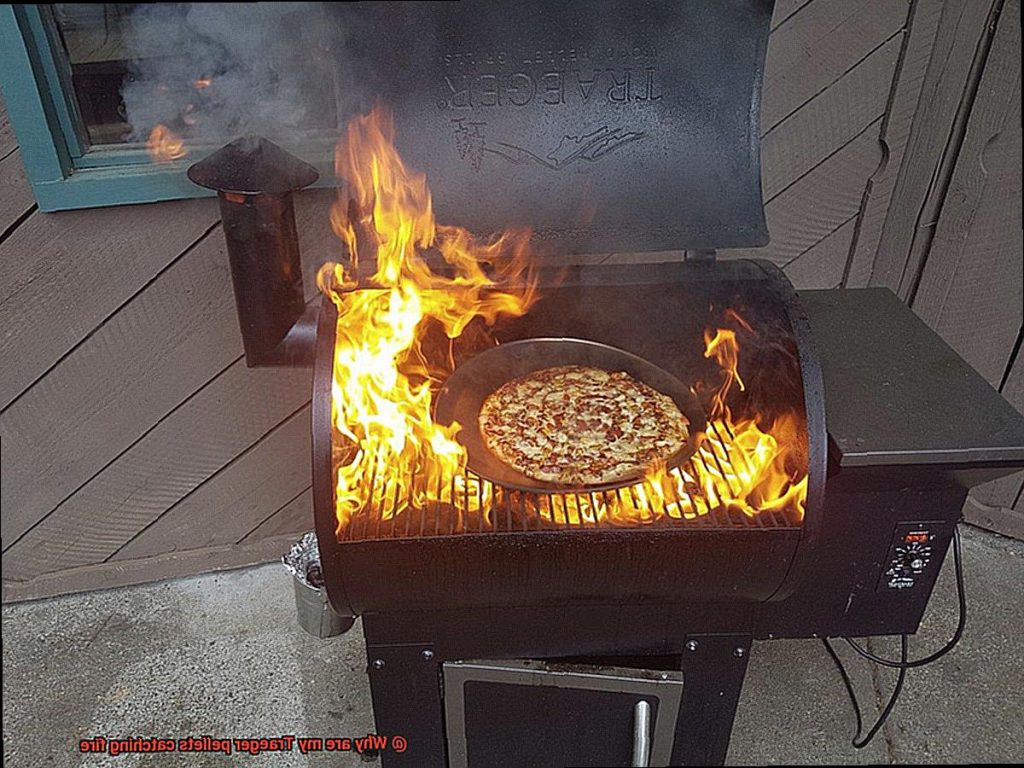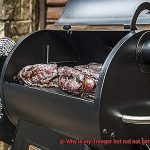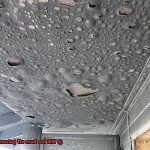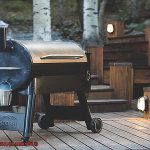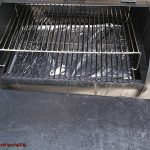Have you ever had your Traeger pellet grill burst into flames unexpectedly? It’s a terrifying situation that can result in ruined food or, even worse, an out-of-control inferno. Pellet grills are supposed to be one of the safest ways to barbecue and smoke, but when they catch fire, they can be incredibly hazardous. So, what causes Traeger pellets to ignite?
There are several reasons why your Traeger pellets might catch fire, and we’ll explore them all in this blog post. We’ll start with the basics by explaining how pellet grills function before delving into the most common causes of pellet fires. From a dirty grill to experiencing a flare-up, we’ll cover everything you need to know to prevent this dangerous occurrence.
But don’t fret – we’re not just going to identify the problem. We’re also going to provide you with solutions. By the end of this article, you’ll have a better understanding of why your Traeger pellets may catch fire and effective ways to prevent it from happening again. So sit back, grab a cup of coffee and let’s delve deep into the world of pellet grill fires.
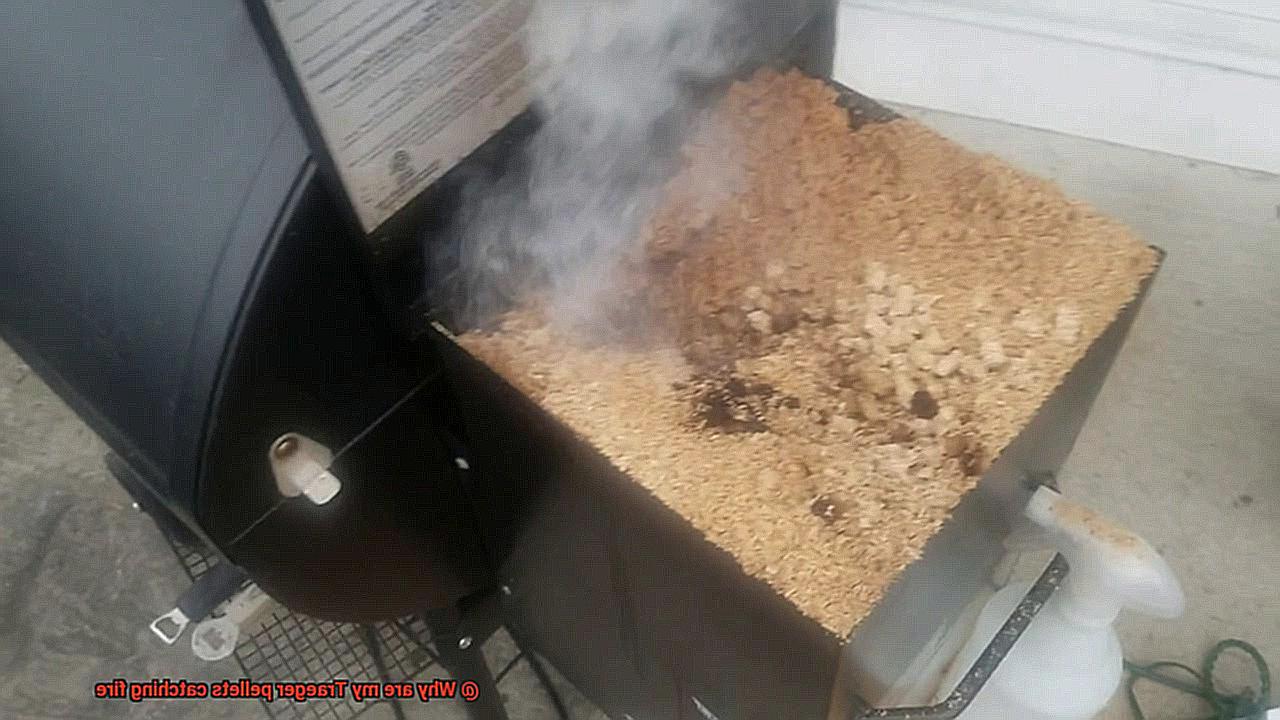
Contents
What are Traeger Pellets?

If you’re looking to take your outdoor cooking game to the next level, Traeger pellets are a must-try. These compressed sawdust and wood shavings offer a natural wood flavor that enhances the taste and aroma of your grilled or smoked food. What’s more, Traeger pellets come in a variety of flavors that allow you to customize your cooking experience to your liking.
Whether you prefer hickory for beef and pork, apple for chicken and fish, mesquite for a bold flavor, oak for a classic taste, cherry for a touch of sweetness, or pecan for a nutty aroma, Traeger pellets have got you covered. And with Traeger grills and smokers featuring an automatic pellet feeder system, using Traeger pellets is as easy as it gets.
All you need to do is load the pellets into the hopper, and the automatic feeder will take care of the rest. Once the pellets reach the fire pot, they are ignited by an electric hot rod. As the pellets burn, they produce heat and smoke that cook your food to perfection.
But before you get started, it’s important to note that pellet fires can occur if certain precautions aren’t taken. To prevent this from happening, make sure to regularly clean out the firepot and check your temperature controller. Additionally, avoid using low-quality or moist pellets that can smolder and eventually catch fire.
Common Reasons for Traeger Pellet Fires
Traeger pellet fires are a frustrating problem that can occur when using a Traeger grill. Not only can it ruin your food, but it can also damage your grill and put you in danger. Therefore, it is essential to understand the common reasons for pellet fires and how to prevent them.
Reason 1: Improper Cleaning and Maintenance
Over time, grease and ash can accumulate in the firepot and igniter, leading to premature ignition of pellets. It is vital to clean these parts of the grill regularly to prevent this from happening. Failing to do so can result in a fire that can quickly spread throughout the grill.
Reason 2: Low-Quality Pellets
Using low-quality pellets that contain too much sawdust or other debris can cause them to burn too quickly and at a higher temperature than intended. This can lead to flames and scorching of the food. It is important to use high-quality, food-grade pellets with minimal impurities to ensure safe and even cooking.
Reason 3: Overloading the Hopper
The hopper has a specific capacity, and filling it beyond its recommendation could lead to fires. Using too many pellets at once can cause them to ignite before reaching the firepot. Therefore, it’s crucial to follow the manufacturer’s guidelines for pellet usage and not overload the grill.
Reason 4: Wind
Wind blowing into the grill can cause the pellets to ignite before they reach the firepot. Positioning the grill in a sheltered area or using a windbreak can help mitigate this issue. It’s essential to take precautions against wind, especially during outdoor cooking.
Reason 5: Malfunctioning Temperature Controller
A malfunctioning temperature controller can cause the grill to overheat, leading to pellet ignition. Regularly checking the temperature controller and ensuring that it’s functioning correctly is crucial for safe grilling practices.
Buildup of Ash in the Firepot
Attention all grill masters. Nothing ruins a good cookout like a pellet fire caused by the buildup of ash in the firepot. Don’t let this happen to you. Here are some expert tips to keep your grill running smoothly.
First and foremost, regular maintenance is key. After each use, make sure to clean out the firepot using a vacuum or small brush to remove any ash or debris. This will ensure proper airflow and prevent uncontrollable ignitions.
It’s also important to keep an eye on your firepot for any signs of damage or wear and tear. A damaged firepot can cause uneven heating, leading to pellet fires. Replacing a worn or damaged firepot is an easy fix that can save you from dangerous situations.
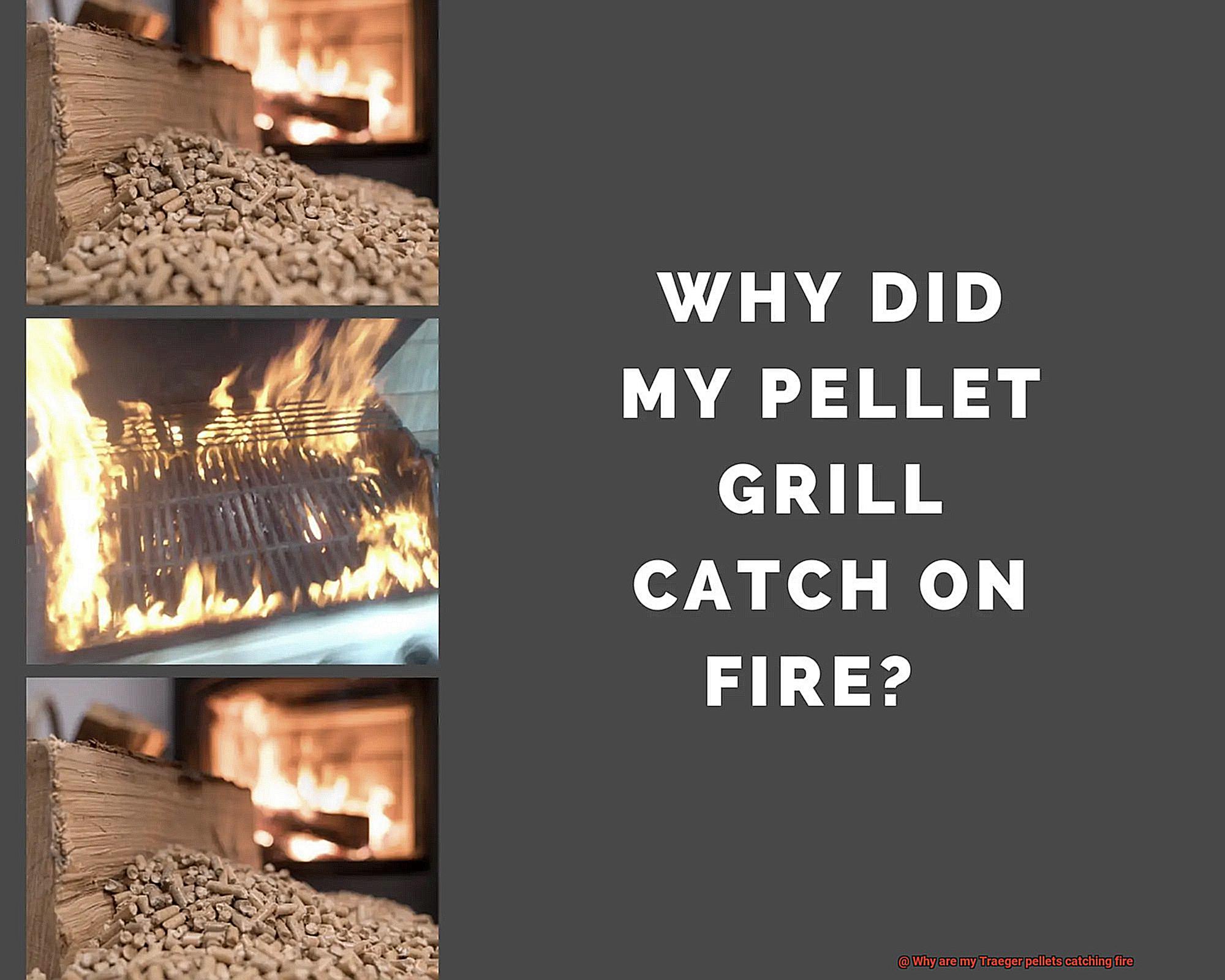
Inferior quality pellets are another culprit for ash buildup in the firepot. These pellets contain more bark and impurities that produce more ash than high-quality pellets made from pure hardwoods. By choosing high-quality pellets, you can minimize ash buildup, which in turn reduces the risk of pellet fires.
To sum it up, regular maintenance, checking for damage, and using high-quality pellets are essential in preventing the buildup of ash in the firepot. By following these simple steps, you can keep your Traeger pellet grill safe and enjoy delicious meals without any undesired flare-ups.
Malfunctioning Temperature Controller
Imagine biting into a perfectly grilled steak, only to have your cookout turn into a fiery disaster. If you’re not careful, a malfunctioning temperature controller on your Traeger pellet grill can cause the pellets to ignite and start a fire. But fear not, with proper care and attention, you can prevent this from happening.
Temperature controllers are responsible for regulating the heat of your grill and ensuring that your food cooks evenly. However, if they malfunction, they can cause the pellets to burn at a much higher temperature than intended, leading to a fire. Here are some common issues that can lead to pellet fires caused by temperature controller malfunctions:
- Stuck in the “high” position: One common issue with malfunctioning temperature controllers is that they can become stuck in the “high” position. This causes the grill to continue heating up even when it has reached its desired temperature, resulting in the pellets burning too hot and too fast, eventually catching fire.
- Incorrect calibration: Another issue is that the temperature controller may not be calibrated correctly, causing it to display an incorrect temperature reading. This can lead to the grill being too hot or too cold, which can also cause pellet fires.
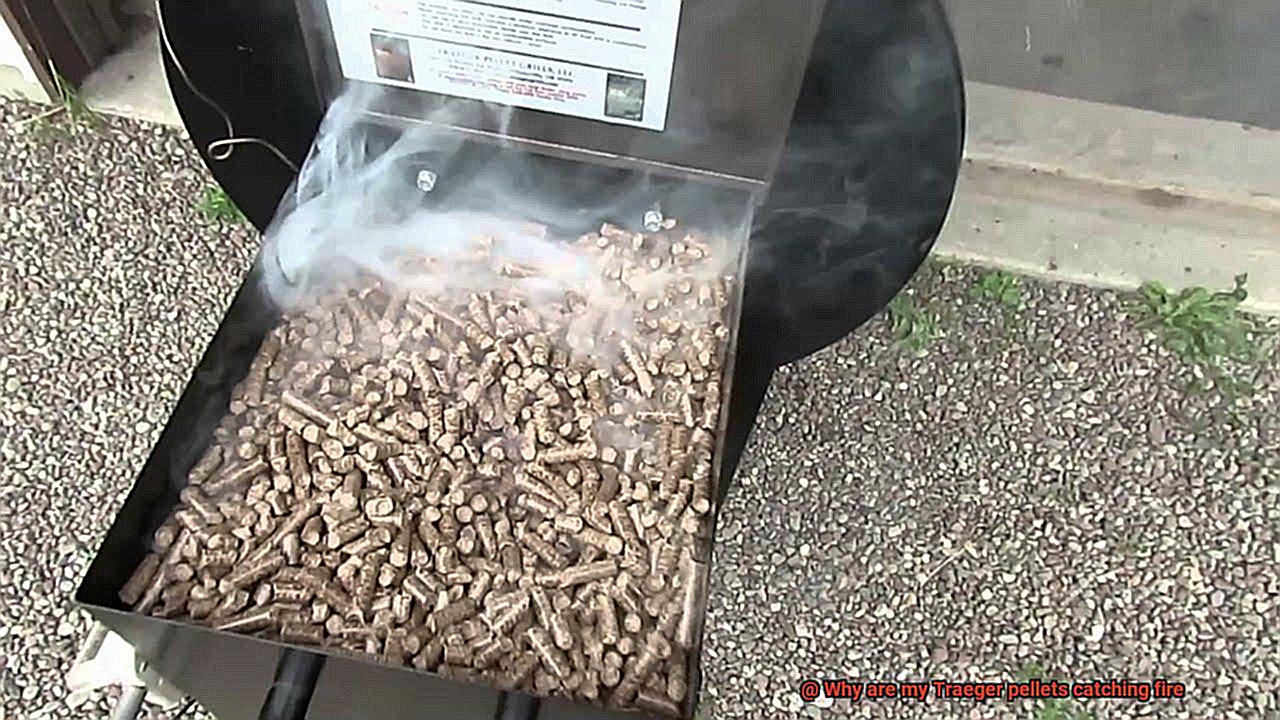
To avoid pellet fires caused by temperature controller malfunctions, it is essential to inspect and maintain your Traeger grill regularly. Check the controller for any signs of damage or wear and tear, and ensure that it is properly calibrated. Always monitor the temperature of your grill closely while cooking and never leave it unattended.
If you suspect that your temperature controller is malfunctioning, it’s best to have it inspected by a professional. If your Traeger grill is still under warranty, contact Traeger customer support for assistance. They may be able to provide you with a replacement part or repair service.
Low-Quality or Moist Pellets
It’s time to take a closer look at the quality of your pellets. Low-quality or moist pellets could be the hidden culprit behind those pesky fires. But don’t worry – we’ve got all the information you need to prevent these disasters from happening.
Firstly, let’s talk about low-quality pellets. These pellets are often made from inferior wood or contain fillers and binders that don’t burn cleanly. When burned, they produce a lot of ash that can clog up your grill’s auger and cause the temperature to fluctuate. This fluctuation can cause your pellets to ignite and catch fire – a situation no grill master wants to deal with.
But that’s not all – moisture can also affect pellet quality. Pellets that are too moist can create excessive smoke and creosote buildup, which can lead to fires. Even worse, moisture can cause the pellets to swell and break down, making them difficult to feed into the grill’s auger.
To avoid these issues, invest in high-quality pellets made from 100% hardwood with no fillers or binders. High-quality pellets produce less ash and reduce the chance of pellet fires. Plus, they burn consistently, providing a smoother grilling experience. Make sure to buy from reputable brands and check the label for 100% hardwood.
In addition to using high-quality pellets, it’s crucial to store them in a dry location. Moisture is the enemy of good pellets, causing them to swell and break down, leading to feeding problems in your grill’s auger. Keep your pellets in airtight containers or bags and avoid storing them in damp areas such as basements or garages.
To summarize, here are some key takeaways:
- Invest in high-quality pellets made from 100% hardwood with no fillers or binders.
- Store your pellets in a dry location to prevent moisture from seeping in.
- Check the label of your pellets for 100% hardwood and buy from reputable brands.
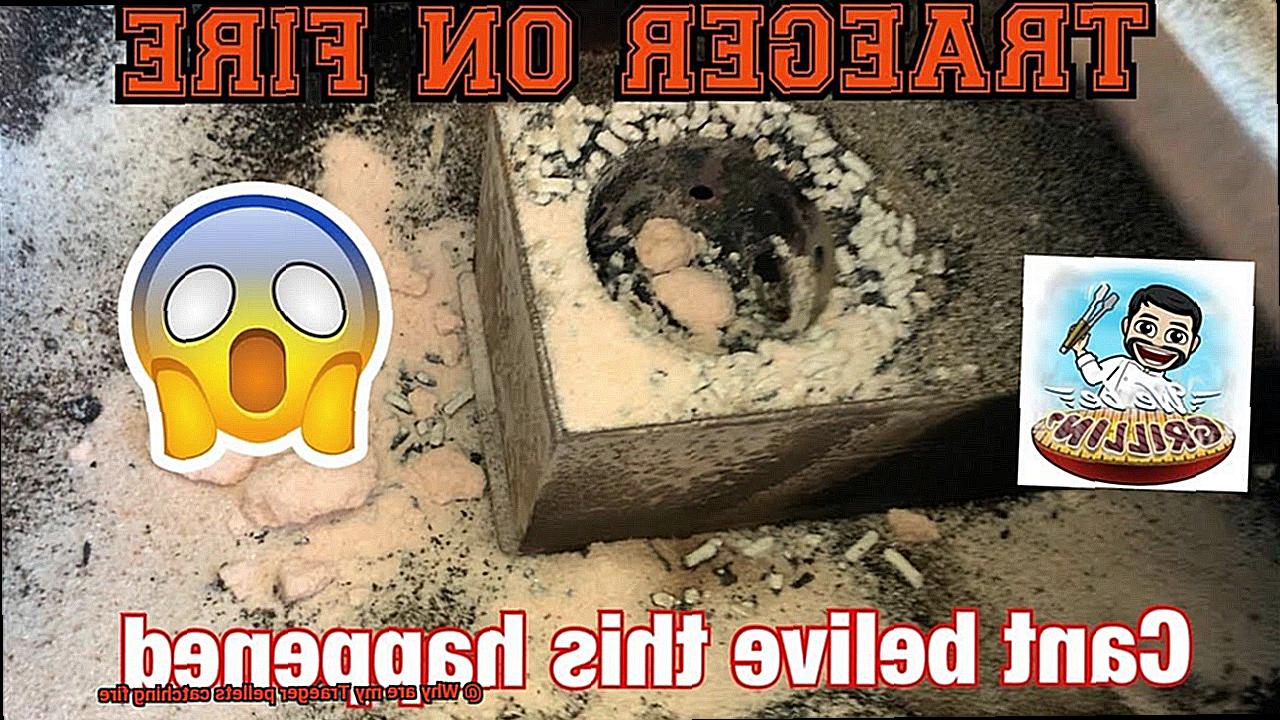
Overly Full Hopper
You know that the secret to a perfect BBQ lies in using high-quality pellets. But did you know that an overly full hopper can cause your pellets to catch fire? Yes, you heard that right. Your love for filling things to the brim can actually ruin your grilling game.
So, let’s get into the details of why an overly full hopper can cause pellet fires. When you fill your hopper to the top, the pellets tend to expand as they absorb moisture from the air. This expansion can cause the pellets to ignite and catch fire, especially when you start up your grill. But that’s not all. The type of pellets you use also plays a role in an overly full hopper. Denser pellets take up more space in the hopper, leaving less room for air circulation. This lack of airflow can cause the pellets to overheat and ignite.
But worry not. We’ve got some expert tips to help you avoid an overly full hopper and prevent pellet fires:
- Fill your hopper only up to ¾ of the way. This will allow for proper air circulation and prevent the pellets from expanding and catching fire.
- Use high-quality pellets that are designed specifically for your grill. Avoid low-quality or moist pellets that can ignite and cause chaos.
- Clean out your hopper regularly to prevent any buildup of debris or ash that can affect the performance of your grill.
If you notice that your hopper is overflowing or your pellets are catching fire, turn off your grill immediately and let it cool down before removing any excess pellets.
User Error
If your pellets catch fire, it can ruin your entire grilling experience. One of the leading causes of this issue is user error. But don’t despair – with a few helpful tips and tricks, you can avoid these dangerous situations and enjoy your Traeger pellet grill to the fullest.
Firstly, leaving the lid open for too long is a common mistake that can lead to a fire. When the lid is open, air flows freely into the grill, causing the temperature inside to increase rapidly. If the temperature gets too high, it can ignite the pellets and cause a fire. So remember to keep an eye on your grill and close the lid when necessary.
Another crucial factor to consider is cleaning your grill regularly. Pellet grills require frequent maintenance to prevent pellet buildup and other debris from clogging the grill’s components. Neglecting this step can lead to uneven heating and hot spots that can ignite the pellets and cause a fire. Therefore, make sure to clean your grill frequently and keep it in good working condition.
The type of pellets you use is also important in avoiding pellet fires. Some types of pellets have a higher moisture content than others, making them more prone to igniting. It’s essential to read the manufacturer’s instructions and select pellets that are recommended for your specific grill model.
Finally, overloading your grill with too much food or pellets can cause uneven heating and hot spots, leading to pellet fires. To avoid this, cook in smaller batches and monitor your grill closely.
Preventative Measures to Avoid Pellet Fires
Grilling is a beloved pastime for many, but it’s important to take precautions to avoid pellet fires that can quickly turn your BBQ dreams into a disaster. As an expert on this topic, I’ve compiled a list of preventative measures to ensure a safe and enjoyable grilling experience on your Traeger grill.
Starting with the basics, keeping your grill clean is essential. Grease build-up is a significant contributor to pellet fires, so be sure to clean the grease tray, drip pan, and firepot regularly. This simple task can prevent disastrous outcomes and extend the lifespan of your grill.
Next up, using high-quality pellets is crucial. Debris or moisture in the pellets can create blockages that lead to combustion, so ensure your pellets are free of both. Store them in a dry place to avoid moisture absorption, and you’re good to go.
Proper airflow is also vital in preventing pellet fires. Ensure that the air vents are unblocked, and your grill’s fan is working correctly. This will guarantee that the pellets burn at the right temperature and prevent flare-ups.
Lastly, never leave your grill unattended, especially when cooking at high temperatures. Always monitor it while cooking and turn off the grill immediately if you notice any unusual flames or smoke. Investigate the cause before resuming cooking to avoid further complications.
By following these preventative measures, Traeger users can enjoy grilling without worrying about pellet fires. Remember, taking these precautions seriously is essential as pellet fires can be dangerous and cause damage to both the grill and surrounding areas.
h5089QI8Q2s” >
Conclusion
In conclusion, a Traeger pellet fire can quickly turn your grilling experience into a nightmare. Not only can it ruin your food, but it can also put you in harm’s way. However, there are ways to prevent this dangerous situation from happening.
Regular cleaning and maintenance of your grill are crucial to avoid grease and ash buildup in the firepot and igniter. Using high-quality pellets with minimal impurities and avoiding overloading the hopper can also reduce the risk of pellet fires.
Other factors that contribute to pellet fires include wind blowing into the grill, malfunctioning temperature controllers, low-quality or moist pellets, and user error. To prevent these situations from occurring, it’s essential to position your grill in a sheltered area or use a windbreak to mitigate wind effects. Inspecting your grill regularly for any signs of damage or wear and tear is also vital.
Investing in high-quality pellets made from 100% hardwood with no fillers or binders is crucial to prevent ash buildup in the firepot. Additionally, storing pellets in dry locations can help avoid moisture absorption that leads to feeding problems in your grill’s auger.
Finally, always monitor your grill while cooking at high temperatures and never leave it unattended. By following these preventative measures, you can enjoy delicious meals without worrying about pellet fires on your Traeger grill.

